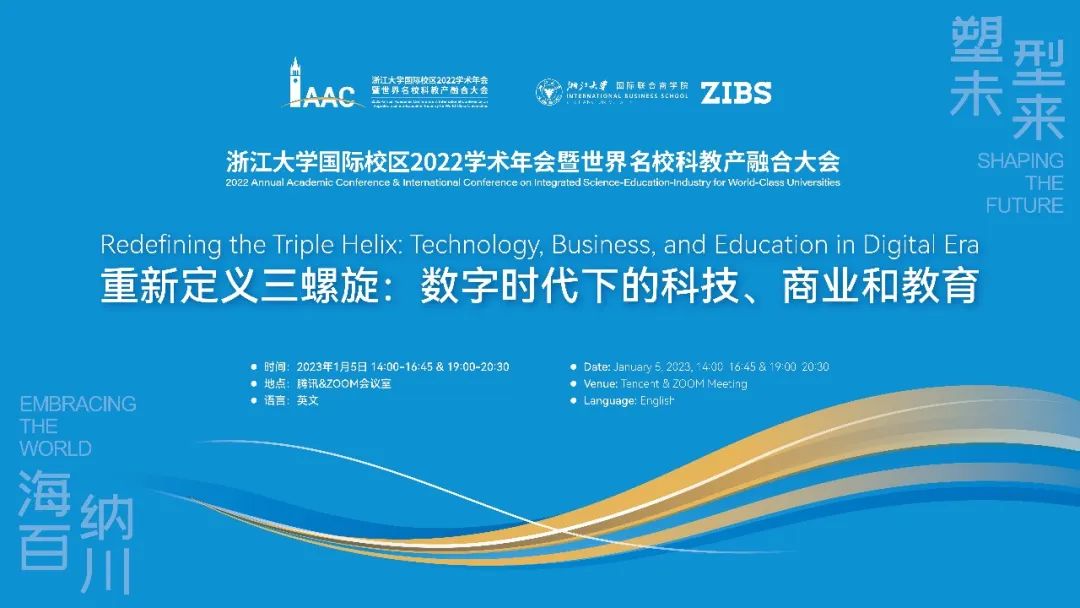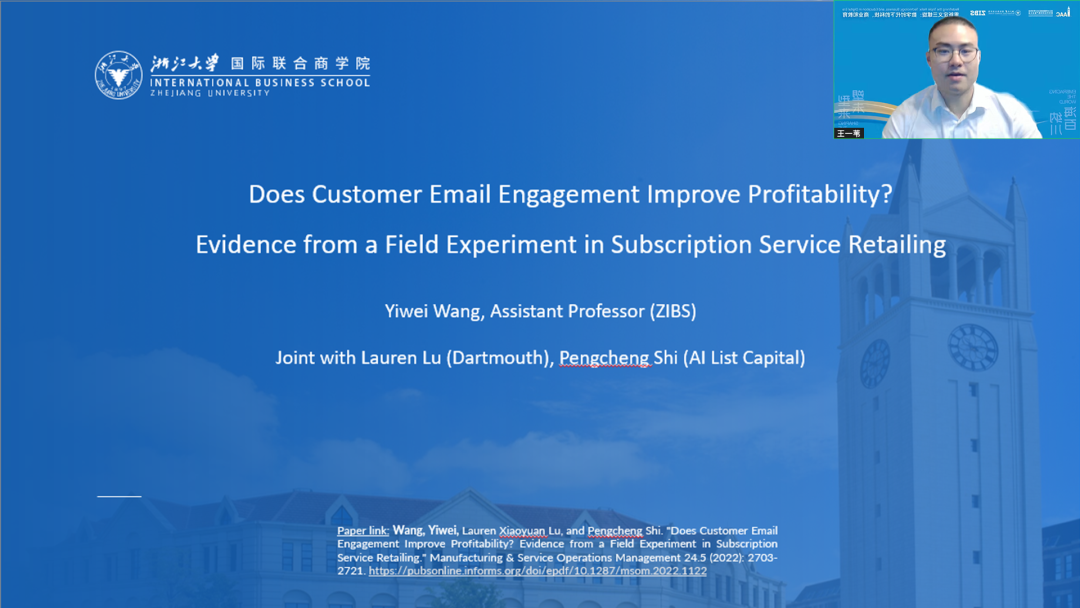//
2022 ZIBS Forum, on the theme of "Redefining the Triple Helix: Technology, Business, and Education in Digital Era", was successfully held on 5 Jan, 2023. Scholars and subject-matter specialists presented their recent research findings on digital technology, innovation management, corporate strategy and sustainable development besides other fields of business studies.

The second part of the forum revolved around the integration of academia and industry in the new business era. In this session, ZIBS Assistant Professor WANG Yiwei presented his research work – Does Customer Email Engagement Improve Profitability? Evidence from a Field Experiment in Subscription Service Retailing, which was completed in collaboration with Lauren Lu of Dartmouth College and Pengcheng Shi, an angel investor at AI List Capital. Here's the review:

Subscription Model
Our research is about subscription, a business model in which customers must pay a recurring fee at regular intervals for access to a product or service. The subscription model is very popular now, and many companies are using this model, which can be roughly divided into three types:
1
●
Subscriptions of physical services, such as gym membership;
2
●
Subscriptions of products, like different kinds of subscription boxes;
3
●
Subscriptions of information goods, such as video-streaming, software.
The subscription model has many benefits for firms, it can create a stable cash flow, increase customer loyalty, increase customers' life cycle value, etc. If customers use this service regularly, then this model can also bring them a lot of convenience and potentially save them lots of money, and the list goes on.
.png)
Despite these advantages, this model also faces a very big challenge – customer churn. According to a survey released by McKinsey, roughly 40% of subscribers churned within six months of initial enrollment. In practice, there are various ways to improve customer retention and the most predominant way to do it is through so-called customer email engagement, that is, by sending customers emails repeatedly at regular intervals. According to a 2015 survey of retailers and service providers, 81% percent of respondents said they regularly use email to contact customers, and 90% companies claim email engagement is of great strategic value to their company.
So indeed, it's a widely used strategy, but whether this widely used strategy is a panacea, always beneficial, is not so obvious. As customers these days are bombarded with all kinds of engagement, such as email or text messages. Firstly, whether this widely used strategy can really increase subscriber retention is not very clear. Secondly, even if email engagement does increase subscriber retention, it might also increase service consumption, which increases the operating costs to serve the retained customers in the subscription setting. The net benefit of doing email engagement in a subscription context is not clear. The existing literature primarily focuses on the benefits of email engagement on retention but ignores the associated operating costs to serve those retained customers.
.png)
Therefore, our study seeks to fill this gap. Specifically, we try to answer the following questions:
1
How does email engagement affect subscriber retention and service consumption?
2
How should service providers optimize their email engagement strategies to maximize profitability?
Unlike the existing literature, we find that email engagement in the typical subscription setting is interestingly not always beneficial. It is a double-edged sword. So, these companies should use a data-driven approach to optimize their email engagement strategy in a typical subscription setting.
Research & Experiment
Introduction
We collaborated with a large subscription-based car wash chain offering tier subscription services to 168,000 customers. Our sample was 4,077 newly registered subscribers, and we randomly assigned email engagement to 60% of them. We sent them two emails in a month. For the control group, they did not receive any email. We then applied econometric approaches, such as survival analysis and differences-in-differences method, to estimate the impact of this email interaction on key metrics such as user retention and their consumption of services. Building on the descriptive analytics results, we also conducted a data-driven estimation to optimize the email engagement strategies companies currently use and improve their profit. This slide shows the research timeline of our study.
.png)
Our study lasted 6 months, and we defined each 15-day interval as one period, which comes to 12 periods in total. In the first month, the pretreatment period, both the treatment and the control group receive two engagement emails. During the next treatment period, only the treatment group received two engagement emails, but the control group no longer received any engagement emails. During the post-treatment period, which lasted 4 months, nobody received any additional emails, but we still observed consumption and retention patterns for both the treatment and control groups during the post treatment period. Overall, the experimental group received four interactive emails, while the control group received two. To collect detail of consumer behavioral data, we leverage a novel technology called RFID, namely, all subscribers assigned to the experimental or control group were required to attach this RFID to their cars' windshield, which would automatically record their behavior.
1
Email Engagement's Effect on Subscriber Retention & Service Consumption
According to the results we get from empirical estimates, first, we find that email engagement improves subscriber retention, so this is as expected. But we also document that email engagement increases subscribers' service consumption. A month's email engagement increases a subscriber's per period service consumption by 8.8%, provided the subscriber is retained (i.e., not driven by a decrease in customer churn).
So how does email engagement increase subscribers' service consumption? The most widely adopted theory suggests that email engagement acts as a reminder, which immediately increases subscribers' attention to getting the service. If that is the case, we have reason to believe that this immediate increase in consumption will decay over time. As evidenced by many existing studies, we have also found this evidence to support these claims. We also contribute something new to the existing literature, namely, the experimental setting allows us to characterize a fatigue pattern of repeated control email engagement. The engagement effect of the first email is much stronger than that of the second email.
Besides the fatigue pattern, we also find that the pattern of increased service consumption persists even after the engagement stops, indicting long-term habit formation induced by the repeated emails during the post-treatment phase, which we call the "post-engagement effect." Moreover, these post-engagement effects are different for different subscribers. We find that this impact is strongest for basic-level users and weakest for top-level users. It is stronger for people who live in cold-weather states and for people who infrequently utilize the service.
2
Increase in Profitability through Email Engagement
Building on the existing findings, we also conducted a data-driven study to optimize email engagement strategy. As documented, email engagement can increase both customer retention, which increases revenue, and service consumption, which increases costs. So does email engagement increase the profitability of subscription service providers? To answer this question, we conducted a subscriber lifetime value analysis. First, we assign all users in the raw sample to one of six subsamples depending on their service frequency and subscribers' level. For each group, we then adopt a set of discrete-time hazard models over an infinite period to estimate the impact of email engagement strategies on user lifecycle, revenue, costs, and profits.
.png)
We discovered that the current company's full engagement strategy, which involves sending emails to everyone in our subscription sample, is suboptimal. In fact, the company can significantly increase its profits if it uses a selective engagement strategy to only send engagement emails to a subset of profitable subscribers. Moreover, this strategy can be conveniently implemented at this car wash chain's over 130 branches in different states through a simple reprogramming of its CRM software at a minimal implementation cost.
To go beyond the bells and whistles of the current concrete setting, we propose a more general framework to optimize the subscription-based retailer's customer engagement strategy. For example, in our next study, we will collaborate with a Chinese subscription box company to delve into the impact of curated subscription boxes on consumer behavior at these omnichannel retailers.
More reviews of the forum are coming soon, please stay tuned!
*This article is based on the speech made by Assistant Professor WANG Yiwei at 2022 ZIBS Forum. The views and opinions expressed in this article are those of the speaker and do not necessarily reflect the views or positions of ZIBS.
The related research article is officially published in "Manufacturing & Service Operations Management", Vol. 24, No. 5, September–October 2022, pp. 2703–2721. Tap the "Read more" below to read the article.
WANG Yiwei
Assistant Professor

Dr. WANG Yiwei is an Assistant Professor of Operations Management at ZIBS. He obtained his Ph.D. from UC Irvine, Paul Merage School of Business, and his bachelor's degree from UC Berkeley, department of Industrial Engineering and Operations Research. His research uses field experiments, causal inference, and applied economic modelling to study consumer behaviors and operations management problems in online and brick-and-mortar retail settings. His research has been accepted at journals such as Manufacturing & Service Operations Management and Service Science. He currently serves as the Ad Hoc reviewer for Management Science.
